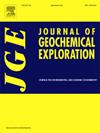Zircon UPb geochronology and geochemistry of ore-bearing rhyolites in the Fuxingtun Ag–Pb–Zn deposit, Great Xing'an Range, NE China: Constraints on petrogenesis and tectonic setting
IF 3.3
2区 地球科学
Q1 GEOCHEMISTRY & GEOPHYSICS
引用次数: 0
Abstract
The Fuxingtun Ag–Pb–Zn deposit, located in the Right Front Banner of Horqin, Inner Mongolia, is a superlarge Ag–Pb–Zn deposit discovered in 2019 in the southern-central Great Xing'an Range. In this work, LA–ICP–MS zircon U![]() Pb, petrogeochemical and zircon Hf isotope data were obtained from ore-bearing rhyolites in the Manketouebo Formation in the Fuxingtun mining area. The zircon U
Pb, petrogeochemical and zircon Hf isotope data were obtained from ore-bearing rhyolites in the Manketouebo Formation in the Fuxingtun mining area. The zircon U![]() Pb ages of the eight rhyolite samples range from 140.1 Ma to 133 Ma, corresponding to the Early Cretaceous. The geochemical characteristics reveal that the rhyolites belong to the high-k calc-alkaline peraluminous series and are characterized by high silicon, alkali and aluminum contents and low iron, magnesium and calcium contents. The total amount of rare earth elements (REEs) is low, and the light and heavy REEs exhibit a certain degree of fractionation, with a moderate negative Eu anomaly. The enrichment of Rb, Th, U, K, Zr, and Hf and the depletion of Ba, Sr, P, Ti, Nb, and Ta correspond to the geochemical characteristics of I-type rhyolites. The source of the rhyolitic magma may have been the remelting of Paleozoic juvenile crust in a postcollisional extensional geotectonic environment.
Pb ages of the eight rhyolite samples range from 140.1 Ma to 133 Ma, corresponding to the Early Cretaceous. The geochemical characteristics reveal that the rhyolites belong to the high-k calc-alkaline peraluminous series and are characterized by high silicon, alkali and aluminum contents and low iron, magnesium and calcium contents. The total amount of rare earth elements (REEs) is low, and the light and heavy REEs exhibit a certain degree of fractionation, with a moderate negative Eu anomaly. The enrichment of Rb, Th, U, K, Zr, and Hf and the depletion of Ba, Sr, P, Ti, Nb, and Ta correspond to the geochemical characteristics of I-type rhyolites. The source of the rhyolitic magma may have been the remelting of Paleozoic juvenile crust in a postcollisional extensional geotectonic environment.

大兴安岭复兴屯银铅锌矿床含矿流纹岩的锆石UPb年代学和地球化学:岩石成因和构造背景的制约
复兴屯银铅锌矿床位于内蒙古科尔沁右前旗,是2019年在大兴安岭中南部发现的超大型银铅锌矿床。本文对复兴屯矿区满克头堡组含矿流纹岩进行了LA-ICP-MS锆石UPb、岩石地球化学和锆石Hf同位素测定。8个流纹岩样品的锆石UPb年龄在140.1 ~ 133 Ma之间,属于早白垩世。地球化学特征表明,流纹岩属于高钾钙碱性过铝系列,具有高硅、高碱、高铝、低铁、低镁、低钙的特征。稀土元素(ree)总量较低,轻、重稀土元素呈现一定程度的分馏,有中等负Eu异常。Rb、Th、U、K、Zr、Hf富集,Ba、Sr、P、Ti、Nb、Ta亏缺,对应i型流纹岩的地球化学特征。流纹岩岩浆的来源可能是碰撞后伸展大地构造环境下古生代幼壳的重熔。
本文章由计算机程序翻译,如有差异,请以英文原文为准。
求助全文
约1分钟内获得全文
求助全文
来源期刊

Journal of Geochemical Exploration
地学-地球化学与地球物理
CiteScore
7.40
自引率
7.70%
发文量
148
审稿时长
8.1 months
期刊介绍:
Journal of Geochemical Exploration is mostly dedicated to publication of original studies in exploration and environmental geochemistry and related topics.
Contributions considered of prevalent interest for the journal include researches based on the application of innovative methods to:
define the genesis and the evolution of mineral deposits including transfer of elements in large-scale mineralized areas.
analyze complex systems at the boundaries between bio-geochemistry, metal transport and mineral accumulation.
evaluate effects of historical mining activities on the surface environment.
trace pollutant sources and define their fate and transport models in the near-surface and surface environments involving solid, fluid and aerial matrices.
assess and quantify natural and technogenic radioactivity in the environment.
determine geochemical anomalies and set baseline reference values using compositional data analysis, multivariate statistics and geo-spatial analysis.
assess the impacts of anthropogenic contamination on ecosystems and human health at local and regional scale to prioritize and classify risks through deterministic and stochastic approaches.
Papers dedicated to the presentation of newly developed methods in analytical geochemistry to be applied in the field or in laboratory are also within the topics of interest for the journal.
 求助内容:
求助内容: 应助结果提醒方式:
应助结果提醒方式:


